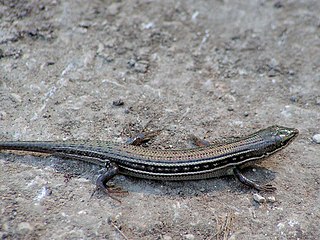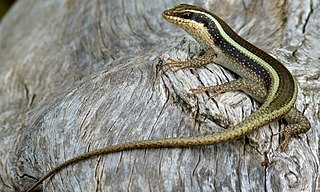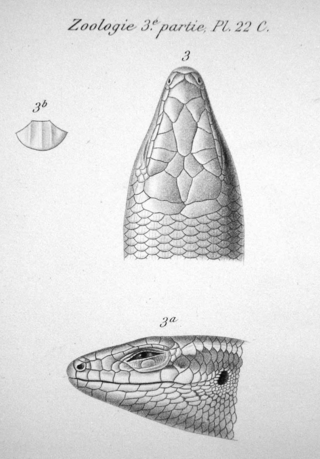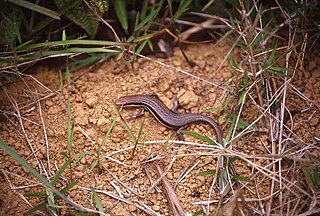
Skinks are lizards belonging to the family Scincidae, a family in the infraorder Scincomorpha. With more than 1,500 described species across 100 different taxonomic genera, the family Scincidae is one of the most diverse families of lizards. Skinks are characterized by their smaller legs in comparison to typical lizards and are found in different habitats except arctic and subarctic regions.

Pseudemoia is a genus of skinks native to southeastern Australia. For similar skinks see genera Bassiana, Lampropholis, and Niveoscincus.

The bridled mabuya or bridled skink is a species of skinks found in North Africa and Middle East. The length of those skinks is up to 22 cm.

The Seychelles skink also known as the Mangouya, is a species of skink in the family Scincidae. It is endemic to the Seychelles.

Trachylepis is a skink genus in the subfamily Mabuyinae found mainly in Africa. Its members were formerly included in the "wastebin taxon" Mabuya, and for some time in Euprepis. As defined today, Trachylepis contains the clade of Afro-Malagasy mabuyas. The genus also contains a species from the Brazilian island of Fernando de Noronha, T. atlantica, and may occur in mainland South America with Trachylepis tschudii and Trachylepis maculata, both poorly known and enigmatic. The ancestors of T. atlantica are believed to have rafted across the Atlantic from Africa during the last 9 million years.

Wright's skink, also known commonly as Wright's mabuya, is a species of lizard in the family Scincidae. The species is endemic to Seychelles. There are two recognized subspecies.

The rainbow skink is a species of Afro-Malagasy mabuya or skink in the subfamily Lygosominae.

The African striped skink, commonly called the striped skink, is a species of lizard in the skink family (Scincidae). The species is widespread in East Africa and Southern Africa. It is not a close relation to the Australian striped skink, Ctenotus taeniolatus.

The African five-lined skink, sometimes called rainbow mabuya, is a species of African skink in the subfamily Lygosominae. T. margaritifera is also known as the rainbow skink.

The Noronha skink is a species of skink from the island of Fernando de Noronha off northeastern Brazil. It is covered with dark and light spots on the upperparts and is usually about 7 to 10 cm in length. The tail is long and muscular, but breaks off easily. Very common throughout Fernando de Noronha, it is an opportunistic feeder, eating both insects and plant material, including nectar from the Erythrina velutina tree, as well as other material ranging from cookie crumbs to eggs of its own species. Introduced predators such as feral cats prey on it and several parasitic worms infect it.

Trachylepis maculata, the spotted mabuya, is a species of skink in the genus Trachylepis recorded from Demerara in Guyana, northern South America. It is placed in the genus Trachylepis, which is otherwise mostly restricted to Africa, and its type locality may be in error. It is an unstriped, olive-brown, grayish animal, with dark spots all over the body. Its taxonomic history is complex due to confusion with Trachylepis atlantica from the Atlantic Ocean island of Fernando de Noronha and doubts regarding its type locality.
Trachylepis tschudii is an enigmatic skink, purportedly from Peru. First described in 1845 on the basis of a single specimen, it may be the same as the Noronha skink (T. atlantica) from Fernando de Noronha, off northeastern Brazil. T. tschudii represents one of two doubtful records of the otherwise African genus Trachylepis on mainland South America; the other is T. maculata from Guyana.

Trachylepis capensis is a species of skink, a lizard in the family Scincidae. The species is native to southern Africa.
Blue-tailed skink may refer to:
Monard's skink is a species of skink. It is endemic to Angola. It is named after Albert Monard, the original species descriptor; the current name is a replacement name to solve secondary homonymy with Euprepis angolensis Bocage, 1872 [=Trachylepis varia ].

Trachylepis maculilabris is a species of skink. Commonly referred to as the speckle-lipped skink or speckle-lipped mabuya. It is distributed through much of sub-Saharan Africa.,

Trachylepis punctatissima, commonly called the montane speckled skink or speckled rock skink, is a lizard in the skink family (Scincidae) which is widespread in southern Africa. The common and adaptable species occurs in a variety of habitat types at middle to high altitudes. It was for a time treated as a southern race of the African striped skink, T. striata.

Trachylepis gravenhorstii, also known commonly as Gravenhorst's mabuya, is a species of skink, a lizard in the family Scincidae. The species is endemic to Madagascar.
Böhme's grass skink is a species of skinks in the family Scincidae. The species is endemic to Ethiopia. It was first described in 2020.














